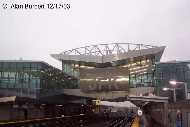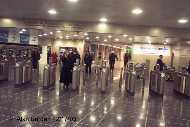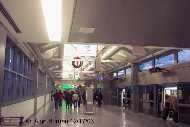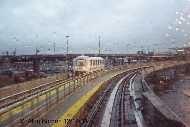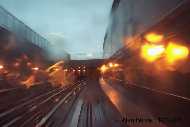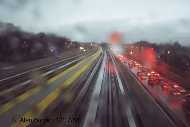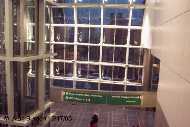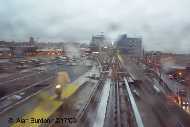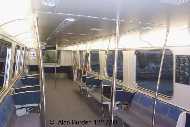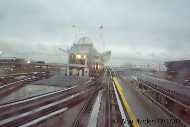Trip ReportOpening Day On The JFK AirtrainDecember 17, 2003text and photos by
Click small photos to see larger; all larger photos are less than 27K Well at long last the JFK Airtrain opened for business today at 2:00 PM. For the first day, until midnight tonight, they were offering free rides. So I decided to take advantage of their generosity. I set out from midtown Manhattan on a Far Rockaway bound A train.
There are plenty of Metrocard machines, along with a staffed window at which to pay, should you need to increase the amount of money on your Metrocard. The one thing that is unclear here, is just what happens if one is coming from the airport. There is only one set of turnstiles here, not one set for the Airtrain and another for the subway. I'm guessing that someone headed to the airport swiping their Metrocard is charged $5, while someone headed out from the airport is charged $7 ($5 for the Airtrain & $2 for the subway).
Once on board the automated two-car train, you are quickly and quietly whisked from station to station. Station A is the Howard Beach station. The first stop on this loop is Station B (Lefferts Blvd) and the long-term parking lots. Shortly after leaving Station B, the train storage area and shops are passed on the left side of the train.
Moving on, just prior to the next station, this line is joined by the line from Jamaica. Trains from both lines stop at Station C (Federal Circle). Here one can find hotel shuttles & rental cars. From here we proceed to the airport terminals themselves.
We entered the terminal loop between the stations for terminals 8 & 9 and 1. We then turned to the right to run counter-clockwise and then made our first stop at terminal 1. On the outer loop one encounters the terminals in numerical order, while of course anyone riding the inner loop would be counting down from 9 to 1.
This split level arrangement sets up the tracks for the flyovers just north of Station C, as the line from Jamaica joins & splits with the Howard Beach line. This avoids the conflict of having to cross-over out-bound Howard Beach trains on the Jamaica line's in-bound track. Conversely the in-bound Jamaica trains don't have to cross-over the Howard Beach line's out-bound tracks. This arrangement permits a steady and smooth flow of trains, and allows for headways of two minutes at peak times. Aside from wanting to see the inside of this station, I needed to detrain here if I wished to go to the Jamaica station. The train that I had been on would be returning to Station A/Howard Beach from here. After exploring this station for a few minutes, I then boarded an inbound train from Jamaica, so I could run around the airport a second time. After the two tracks return to the same level upon leaving this station, they gradually descend into a short tunnel under a few airport roads. This is the system's only tunnel. As we exit the tunnel and once again climb above grade level there are a few switches that connect to a short track. This short track in turn then connects to the inner loop, to allow trains to be added and taken off the inner loop.
At present though, one must go outside to connect to the subway. Hopefully this will be fixed soon, as with today's rain, I for one would not have wanted to lug my luggage outside in the rain, just to connect. Several elevators and escalators are available for use to reach the street level and the connection to the NYC subways.
Finally there is a counter area where one will be able to check-in for flights and also check one's luggage. Not all airlines will be represented here, but the major ones will be. This check-in area was not yet in use on this first day of operations. What is unclear though, is how the airlines plan to get the checked bags to the airport. Will a Skycap simply ride the train? Or do they plan to use a truck, which could get stuck in traffic on the Van Wyck Expressway? The Howard Beach station does not offer the above check-in perk. A short ride on the E train with a connection to the #7 train, and I was back home. Total cost to me for today $4.00 thanks to the free ride on the Airtrain. Starting tomorrow this same ride will cost 14 bucks.
Since the system is automated, there are no signals to control spacing of trains. There are however dwarf-sized signals at the switches, but they are not typical railroad signals at all. While each signal consists of three aspects, like typical subway signals, the lights are not red, green, & yellow. Instead the top two aspects display a white arrow indicating the direction to which the switch is set. The bottom aspect is red to indicate that either the switch is in motion or it is not safe to proceed for other reasons.
I could clearly see that the switch in front of my train was set to reverse, so that my train would crossover to the outbound track, even though it's counterpart was still in the normal position. Not only was the counterpart switch set to norm; it was busy handling the other outbound train. So our signal was showing a red aspect. Once the other train had cleared the counterpart, and placed a little distance between my train, the other switch was reversed and we were allowed to proceed. The Port Authority of NY & NJ has issued a rather nice brochure that is available in all of the stations. An Adobe Acrobat version is also available on the PA's website and it includes a map of the system, which will help to give you some idea of what I've described above along with a few pictures. You can find the online version of the brochure at the PA's website, by clicking here. Please note that you must have Adobe Acrobat Reader installed on your computer. A free version of the reader is available here. |

| Menus: |
| Back Home Forums Chat Search Site map Print this page |
| Trips: New 2012 2011 2010 2009 2008 2007 2006 2005 2004 2003 2002 Older |
